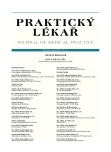-
Medical journals
- Career
One hunfred years of allergen immunotherapy, first year in the form of sublingual tablets
Authors: E. Pekarová; Gürtler L’.
Authors‘ workplace: Alergo-imunologická ambulancia, Banská Bystrica ; Prednosta: MUDr. Milan Kmeť, PhD. ; FNsP F. D. Roosevelta, Interná klinika
Published in: Prakt. Lék. 2011; 91(9): 544-548
Category: Public relations
Overview
Allergy is one of the most common chronic diseases in the world. Treatment with H1-antihistamines, antileukotrienes, beta-2-adrenergic receptor agonists and corticosteroids provide a temporary suppression of inflammatory mediators and immune cells and release the symptoms but doesn’t solve the cause of the disease. The only causal treatment which can reprogram the specific immunity from allergy to tolerance is allergen specific immunotherapy (ASIT).
The aim of ASIT is the induction of an immune-tolerant state in which allergen-specific T regulatory cells (Treg) play the main role. These Treg cells inhibit both Th1 and Th2 responses through the production of IL-10 and TGF-beta. A decrease in the IgE/IgG4 ratio has been observed which correlates with the clinical efficacy. ASIT involves repeated administration of stepwise increasing doses of the allergen given subcutaneously or orally / sublingually.
Sublingual immunotherapy takes advantage of an important physiological mechanism of oral mucosal tolerance. Draining lymph nodes represent specialized microenvironment favoring the induction of mucosal tolerance through the production of blocking IgG antibodies and the induction of T suppressive lymphocytes. Many EBM trials approved safety and effectiveness of SLIT. In the form of sublingual tablet makes the manipulation, dosage and compliance of patient more easier.Key words:
allergy, allergen tolerance, ASIT, SLIT.
Sources
1. Agostini, F.,Tellarini, L., Canonica, G.W. et al. Safety of sublingual immunotherapy with a monomeric allergoid in very young children. Allergy 2005, 60, p. 133-134.
2. Akdis, M., Akdis, C. Therapeutic manipulation of immune tolerance in allergic disease. Nature Reviews Drug Discovery, 2009, 8, 10, p. 645-659.
3. Alvarez-Cuesta, E., Bousquet, J., Canonica, G.W. et al. Standards for practical allergen-specific immunotherapy. Alergy 2006, 61, 82, p. 1-20.
4. Bieber, T., Simon, H.U. Allergen-specific immunotherapy: current concepts and future directions. Allergy 66, 6, p. 709-712.
5. Canonica, G.W., Bousquet, J., Casale, T. et al. Sub-Lingual Immunotherapy:World Allergy Organization Position Paper 2009. Allergy 2009,64, Suppl 91.
6. Didier, A., Malling, H.J., Worm, M. et al. Optimal dose, efficacy, and safety of once-daily sublingual immunotherapy with a 5-grass pollen tablet for seasonal allergic rhinitis, JACI 2007, 120, 6, p. 1338-1345.
7. Jutel, M., Akdis, C.A. Immunological mechanisms of allergen-specific immunoherapy. Allergy 2011, 66, p. 725-732.
8. Kolfschoten Neut, M., Schuurman, J., Losen, M. et al. Anti-Inflammatory Activity of Human IgG4 Antibodies by Dynamic Fab Arm Exchange, Science 2007 317 9, p. 1554-1557.
9. Larché, M., Akdis, C.A., Valenta R. Immunological mechanisms of allergen-specific immunotherapy. Nature Reviews Immunology 2006, 6, 10 p. 761-771.
10. Moingeon, P., Batard,T., Fadel, R. et al. Immune mechanisms of allergen-specific sublingual immunotherapy. Allergy 2006, 61, p. 151-165.
11. Panzner, P. Oralair - sublingvální tablety pro specifickou imunoterapii alergie zpusobené pyly trav. Alergie 2010, 3, p. 207-212.
12. Passalacqua, G., Compalati, E., Canonica, G.W. Sublingual Immunotherapy: Clinical Indications in the WAO-SLIT Position Paper. WAO Journal 2010, 3, p. 216-219.
13. Penagos, M., Compalati, E., Tarantini, F. et al. Efficacy of sublingual immunotherapy in the treatment of allergic rhinitis in pediatric patients 3 to 18 years of age: a metanalysis of randomized, placebo-controlled, double-blind trials. Ann. Allergy Asthma Immunol. 2006, 97, p. 141-148.
14. Ring, J., Gutermuth, J. 100 years of hyposensitization: history of allergen-specific immunotherapy (ASIT). Allergy, 2011, 66, p. 713-724.
15. Senti, G., Moos, S., Kündig, T.M. Epicutaneous allergen administration: is this the future of allergen-specific immunotherapy? Allergy 2011, 66, p. 798-809.
16. Valenta, R. From Allergen Genes to Allergy Vaccines. Annu. Rev. Immunol. 2010, 28, p. 211-41
17. Wahn, U., Tabar, A., Kuna, P. et al. Efficacy and safety of 5-grass-pollen sublingual immunotherapy tablets in pediatric allergic rhinoconjunctivitis. JACI 2009, 123 1, p. 160-166.
Labels
General practitioner for children and adolescents General practitioner for adults
Article was published inGeneral Practitioner

2011 Issue 9-
All articles in this issue
- Demodicidosis
- Glomus tumour of a finger
- One hunfred years of allergen immunotherapy, first year in the form of sublingual tablets
-
Základy kognitivní, afektivní a sociální neurovědy
IX. Altruismus - Primary prevention of cancer
- Orthostatic hypotension
- Continuing Education of General Practitioners and new Czech Medical Chamber rules
-
Program Zdraví 2020
Budoucnost evropské zdravotní politiky - A view of young Czech practotioners on vocational training – research questionnaire
- Interaction of alcohol and other drugs: a serious problem
- General Practitioner
- Journal archive
- Current issue
- Online only
- About the journal
Most read in this issue- Orthostatic hypotension
- Glomus tumour of a finger
- Demodicidosis
- Interaction of alcohol and other drugs: a serious problem
Login#ADS_BOTTOM_SCRIPTS#Forgotten passwordEnter the email address that you registered with. We will send you instructions on how to set a new password.
- Career

